
Mal i ssi ka toenda.
Words become seeds.
Korean proverb

Earliest Example of Writing
In the late 1920s and 1930s, the Library
of Congress acquired a collection of clay tablets that contain
the earliest examples of writing held in the Library. The
tablet displayed here is written in Sumerian and concerns
the disbursements of wages to named supervisors of day laborers.
The listed disbursements date to 2039 B.C., the year that
King Amar Suen sacked the city of Sasrum.
|

Cuneiform tablet.
Mesopotamia, 2039 B.C.
Page 2
Hebraic Section,
African and Middle Eastern
Division (146)
|


|

Type specimens.
Korea, ca. thirteenth century.
Brass, iron, copper, and wood.
Asian Division
(152)
|
Korean Metal Movable Type
These are specimens of the earliest
known movable type. The first font was cast in the 1230s,
some two hundred years before Gutenberg "invented" movable
type in Europe. Though the exact year of these specimens is
difficult to establish, judging from their crude and heavy
workmanship they would seem to date from the earliest years.
The Korean alphabet was not invented until the fifteenth century.
These are Chinese characters, which are still widely used
today in written Korean, along with the Korean alphabet.
|

Never memorize what you can look up in books.
Albert Einstein

First Book Published in the Western Hemisphere
According to the tenets of sixteenth
century international law, the only legitimate reason to conquer
other peoples was to convert them to Christianity. In 1541
John Cronberger, a master printer, went to Mexico specifically
to establish a press there. Archbishop Juan de Zumárraga
(1468-1548) wanted the first volume produced to be this catechism
in the Spanish language to teach the faith to the indigenous
population and to help Spanish settlers hold onto their beliefs
far away from home.
|

Doctrina breve muy provechosa de
las cosas que portenecen a la fe Catholica y a nuestra cristiandad
en estilo llano para común inteligecia
(A brief and very valuable compendium of the facts that pertain
to the Catholic faith and our Christianity, in simple style,
for the average intelligence).
Mexico City: John Cronberger, 1543.
Spanish-American Imprint Collection,
Rare Books and Special
Collections Division (153)
|


|
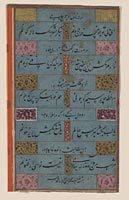
Calligraphy page from
Dirvan-i Jami (Collected
Poetry of Jami).
Isfahan, Iran, early 1700s.
African and Middle Eastern
Division (153.1)
|
Persian Calligraphy Page
According to an ancient Persian saying
about the value of the written word, "A pen and a drop of
ink/Makes the whole world think." Since around 700 B.C., Persian
calligraphers have demonstrated this saying by creating exquisite
works, such as this illuminated, hand-done page from a longer
poem by Nuruddin Abdur Rahman Jami (1414-1492), the last great
poet of classical Persian literature. Although in the West,
calligraphy is considered penmanship, in Islamic countries
it is an art. Artists from Persia (now Iran) are considered
the best practitioners and are in demand to create Korans,
illustrate classic works, and design tiles for mosques.
|


One Million Pagoda Charms
The printing on these three strips of
rice paper is the second oldest extant example of printing
in the world, dating from around 764. Between 764 and 770,
the Empress Shtoku, grateful for the end of an eight-year
civil war in 764, ordered the Buddist prayers (dharani)
to be printed and placed in "one million" tiny wooden pagodas
as a memorial to the dead and distributed to monasteries throughout
Japan. The Library's collection includes three of the four
dharani which arrived from Japan in 1907 in this pagoda.
|
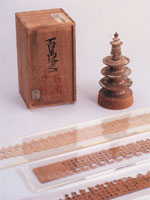
Hyakumanto dharani
(One Million Pagoda Charms).
Detail 1
Woodblock printed sutras and
wooden pagoda, ca. 764.
Japanese Section,
Asian Division
(154a, b)
|

I hear and I forget; I see and I remember; I write
and I understand.
Chinese Proverb

|
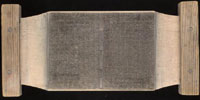
"P'alman taejanggyong"
(Tripitaka Koreana).
Korea, 1231.
Asian Division
(155)
|
Early Korean Woodblock Printing
The carving of the woodblocks for the
Korean Tripitaka (Buddhist canon) began in the
early eleventh century and was completed in 1087. The original
woodblocks were destroyed during the thirteenth century Mongol
invasions. The Tripitaka Koreana that remains
today is a later edition completed in 1251 and consists of
81,200 woodblocks. It is considered to be the finest, in terms
of accuracy and calligraphic beauty, among the twenty some
versions of the Tripitaka. This item is one of
the 1251 edition woodblocks and was given to the Library in
1986.
|


Early Korean Printed Book
Some 200 years before Johannes Gutenberg
made his famous Bibles, the lifework of Yi Kyu-bo (1168-1241)
was set in type in Korea with metal movable type on handmade
mulberry paper. The Yi Munsun Chip includes the
author's historical essays, autobiography, poetry, descriptions
of early printing and warnings against shamanism. The collected
works were edited and printed in about 1241.
|
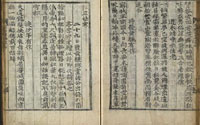
Yi Kyu-bo.
Yi Munsun Chip
(The Collected Works of Yi Munsun).
Korea, 1241.
Korean Collection,
Asian Division
(156)
|


|
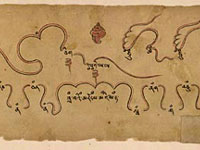
Tibetan Musical Score,
nineteenth century.
Page 2 - Page
3
Tibetan Collection,
Asian Division
(147)
|
Tibetan Musical Score
This Tibetan manuscript is a musical
score used for chanting rituals in Buddhist ceremonies. Curved
lines are used to represent the melody, which would be accompanied
by bells, cymbals, and other instruments. This form of musical
notation, used in Tibet and Mongolia, is thought to be one
of the oldest in the world.
|


Ritual for Worshiping Books
|
|
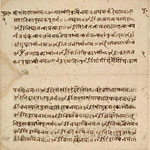
Pustakapuja
(Book of Worship).
Maharashtra, nineteenth or
early twentieth century.
Southern Asian Section,
Asian Division
(148)
|

Bhagavatapurana.
Illustrated manuscript.
Inscribed palm leaves with wooden covers.
Orissa, India: Eighteenth centruy.
Southern Asian Section,
Asian Division
(148.1)
|
|
In the autumn festival of Dipavali or
Divali, Hindus traditionally worship the instruments of their
vocation. Farmers venerate their seed corn and plough, craftsmen
their tools, soldiers their weapons, and so on. Those in learned
professions worship their books. This little manuscript (on
the left) in the Sanskrit language gives the prayers for doing
so.
This palm leaf manuscript of the Bhagavatpurana
(on the right), the most famous version of the story of Krishna,
shows the accumulation of sandalwood past and red powder applied
to the wooden covers over many years of such worship.
|


Thomas Jefferson's Library was on view to the public
for the first time in its history from April 24, 2000 through
November 21, 2001. Originally it was part of the Thomas
Jefferson exhibition. After the exhibition closed,
it remained on display and was incorporated into the first
phase of the World Treasures Exhibition.
|
Thomas Jefferson's Library
The international collections of the
Library of Congress started with the arrival of the Thomas
Jefferson library in 1815. Jefferson's 6,487 volumes, sold
to Congress for $23,950, expanded the scope of the Library
far beyond the bounds of a legislative resource. Jefferson
was a man of encyclopedic interests, and his library included
works on architecture, the arts, science, literature, and
geography. It contained books in French, Spanish, German,
Latin, Greek, and one three-volume statistical work in Russian.
Jefferson believed that the American legislature needed ideas
and information on all subjects and in many languages in order
to govern a democracy. His belief, reflected in the nature
of his library, transformed the Library of Congress.
|
|
|

